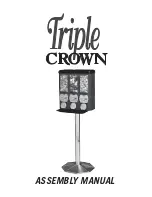
Adjustment
11 - 39
61-054
11
.05.04
Knife stroke on models 574 and 591
Requirement
The knife stroke can be adjusted over a range from
2.0
to
3.5 mm
, allowing the best
possible adaption to all materials used.
1
3
2
-
+
Fig. 11 - 35
●
Adjust crank
1
(nut
2
) in slotted lever
3
according to the
requirement
.
















































